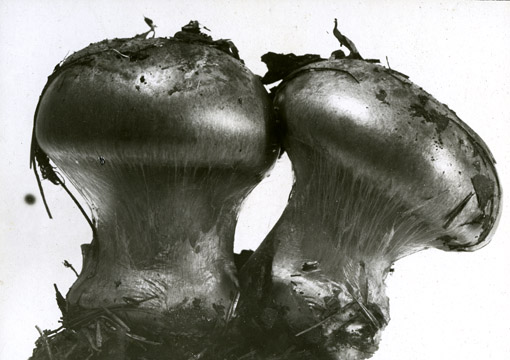
Cortinarius atkinsonianus
CUP-A-020653
Calvin Henry Kauffman named this mushroom for his mentor in mushrooms. He worked for two years as Atkinson's assistant in the early 1900s. You can see Atkinson's influence in Kauffman's photography.
Kauffman went on to a PhD and a professorship at the University of Michigan. He and his students had great impacts on the classification of fungi, and the science of mycology. He studied a broad range of fungi, but loved mushrooms in particular.
In this photo, it is easy to see the cortina, a distinctive feature of Cortinarius species. It is the fibrous veil that connects the stem and the edge of the young caps.
One of the profound limiitations to photography in Aktinson's time was the lack of color technology. Would you like to see this mushroom in color?
In July 19051 Kauffman knelt on the forest floor near Ann Arbor, Michigan. He carefully traced the reddish mycelial cords emanating from a different species of Cortinarius back to its host tree's roots. It wound over the hickory roots and under the hawthorn roots and then, ah! connected to the young red oaks 5 meters away. Nearby he found these mushrooms connected to the roots of a bittersweet vine. Elsewhere, to sugar maples and more red oaks. It was one of the first demonstrations of a single fungus forming mycorrhizal connections with different hosts. This was in an age where the idea that fungi were myccorrhizal was quite new, and the identities of the fungi involved were seldom known. He had to describe a new species to get a name for this one: Cortinarius rubipes, the Red-Foot Cort. But C.H. Peck had given that same name to a different fungus just months before--so Kauffman's name didn't stick. Instead, the fungus Kauffman followed is now called Cortinarius kauffmannii.
